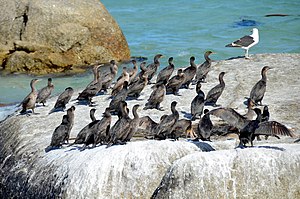Kapscharbe
| Kapscharbe | ||||||||||||
|---|---|---|---|---|---|---|---|---|---|---|---|---|

Cape shark ( Phalacrocorax capensis ) |
||||||||||||
| Systematics | ||||||||||||
|
||||||||||||
| Scientific name | ||||||||||||
| Phalacrocorax capensis | ||||||||||||
| ( Sparrman , 1788) |

The Cape Shark ( Phalacrocorax capensis ) is a species of bird in the genus Phalacrocorax within the cormorant family . The black or dark brown colored species colonizes the coasts of South Africa and Namibia . It breeds in colonies and feeds mainly on schooling fish . The IUCN lists the species as " critically endangered ".
Appearance
Cape sharks reach a head-trunk length of 61 to 64 centimeters and a wingspan of a maximum of 109 centimeters. The weight is between 1155 and 1306 grams. Adult birds are completely black or dark brown feathered. The legs are colored gray, as is the beak. The skin at the base of the beak shows a bright yellow color, which can change to reddish during the breeding season . Outside the breeding season, the plumage of some animals is a bit lighter, especially on the neck and head, and can appear brownish. Young birds are similar to adults, but their belly and throat are much lighter in color. The iris is green. There is no gender dimorphism .
distribution and habitat
Cape Shags only colonize the coasts of South Africa and Namibia , primarily in the area of influence of the nutrient-rich Benguela Current . Inland waters and estuaries are only visited sporadically and are not permanently populated. The birds always stay close to the coast and fly no more than a few kilometers out to sea to hunt.
food
The main part of the diet is made up of pelagic schooling fish , which are particularly numerous in the nutrient -rich Benguela Current. The main prey are sardines and anchovies ; near the coast, gobies and invertebrates such as crabs , mussels and octopus are the main prey . Like all cormorants, the species prefers to catch its prey by diving by following and catching it while swimming underwater. As a rule, the species hunts in groups, whereby the schools of fish are driven apart and individual fish can be captured more easily.
Since the plumage of the Cape Shard absorbs water, it has to be dried after a dive. Like most cormorants, Cape Sharks spread their wings and let the sun or wind dry their plumage.
Breeding behavior
The breeding season usually begins in September or October, depending on the start of the heavier rains in spring and early summer. Cape sharks breed in large colonies on the coast and on small islands near the coast. The colonies can reach sizes of over 100,000 breeding pairs. Cliffs are preferred as nest locations, but occasionally artificial structures are also adopted as nest locations, for example ruins, breakwaters or boats that are no longer in use. The nest is always built on level ground even on cliffs, for example on small rocky outcrops or in niches. It is made of sticks and is padded with algae and feathers. Usually 2 to 3 eggs are laid and incubated for 22 to 28 days. The hatched chicks are initially naked. They grow black down after a few days before the cover plumage grows. The young birds fledge after about 9 weeks, but the parents continue to feed their offspring for a few more weeks.
Migratory behavior
Cape sharks are resident birds in large parts of their distribution area , there are only dispersal migrations of young birds after the breeding season. The populations on the west coast of South Africa partly move north in winter and partly reach the Congo Delta .
Systematics
As with all cormorants, the exact systematic position of the Cape Shark within the family is controversial. The species is not divided into subspecies .
Hazard and protection
The IUCN lists the species as " critically endangered " because it is subject to strong population fluctuations. This natural process is due to the periodically changing food supply due to changes in the intensity of the Benguela current. However, since the food fish stocks are severely overfished, it is difficult for the species to recover from population collapses.
literature
- Josep del Hoyo , Andrew Elliot, Jordi Sargatal : Handbook of the birds of the world. Volume 1: Ostrich to Ducks. Lynx Edicions, Barcelona 1992, ISBN 84-87334-10-5 .
Individual evidence
- ↑ Phalacrocorax capensis in the endangered Red List species the IUCN 2011. Posted by: Phalacrocorax capensis, 2010. Accessed November 13, 2011th
